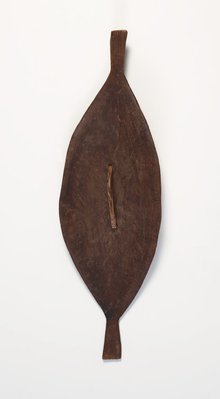-
Details
- Place where the work was made
-
Berrigan
→
New South Wales
→
Australia
- Date
- circa 19th century
- Media categories
- Sculpture , Painting , Woodwork
- Materials used
- carved hardwood and natural pigments
- Dimensions
- 79.0 x 24.0 x 5.0 cm
- Signature & date
Not signed. Not dated.
- Credit
- Purchased 2022 with funds raised from the 2017 Art Gallery of New South Wales Foundation gala dinner and the Aboriginal Art Collection Benefactors
- Location
- South Building, ground level, Grand Courts
- Accession number
- 250.2022
- Copyright
- Artist information
-
attrib. Wemba Wemba artist
Works in the collection
- Share
-
-
About
The term ‘broad’ refers to the flat face of this shield. Broad shields are sometimes called ‘spear’ shields as they are understood to have been used to deflect spears. Southeastern broad shields are created using two techniques: worked from the inner bark of a tree or carved from a solid piece of wood. This involves cutting the bark off a tree or a single piece of wood, paring it down and shaping it, then adding a cane handle.
The skill and time involved in creating shields indicates their cultural importance. Engraved with myriad lines, southeastern shields best exemplify the region’s artistic cultural practice. These shields are often cloaked in an array of diamonds, zigzags, squares, bands, circles, criss-crosses, and the occasional figure. These iconic designs empower the shield bearer by representing Country and identifying both regional and clan affiliations. As seen in the imagery of both William Barak and Tommy McRae, broad and parrying shields played a central role in Southeast ceremonies. Shields used in performance would often be painted with natural pigments, remnants of which can still be seen on many today.
The majority of broad shields were collected in the 1800s and early 1900s, and mostly without an Ancestor’s name being recorded. Current research is identifying connections between shields, based on the clan designs on their surface, which will hopefully provide further clues as to the identity of their makers and their language group.
It is likely this shield was made by a Wemba Wemba artist, as a clear comparison can be made with a broad shield held in the collection of Museums Victoria, who have recorded their maker as Wemba Wemba (see Giyami, New South Wales, #26166). This shield was collected from Berrigan, less than 100 kilometres away from Deniliquin in New South Wales, where the Museums Victoria shield was collected from.

